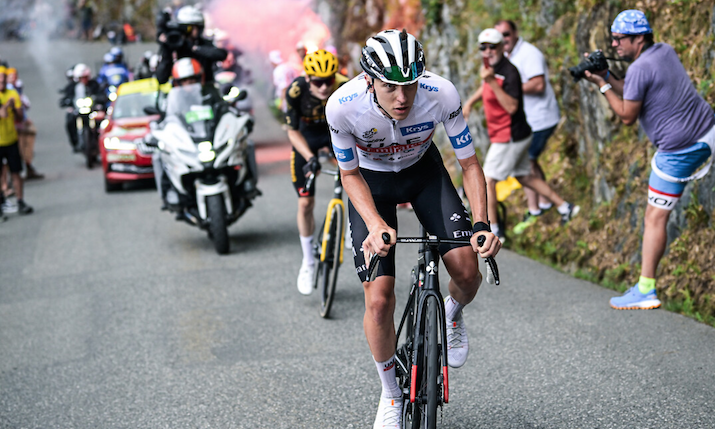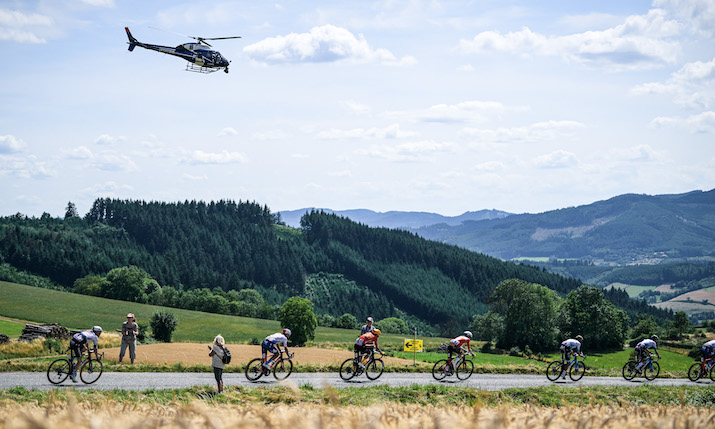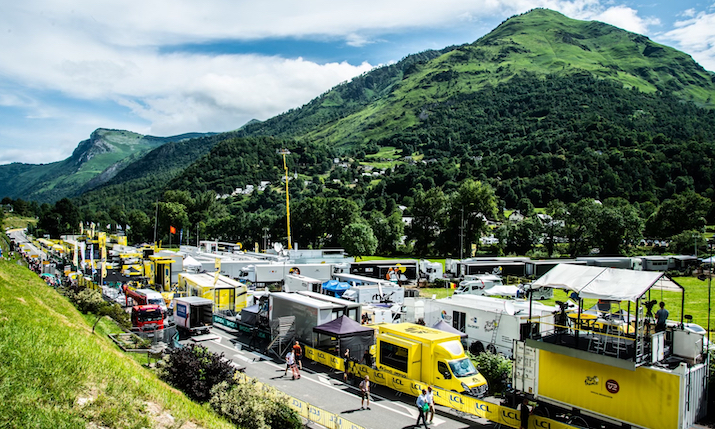Live from the Tour de France 2023: The technical set-up behind the Grande Boucle

The 2023 Tour de France was marked by the Pogacar/Vingegaard duel for the yellow jersey. EMG’s RF motorcycles were closest to the cyclists Credit: ASO/Charly Lopez
As well as being a major event in the international sporting calendar, the Tour de France also represents a significant broadcasting achievement with the host broadcasters required to capture action across all 3,404 km of the course for television viewers in nearly 190 countries around the world.
“It’s truly a fantastic team effort,” summarises Guillaume Kleszcz, head of productions and broadcast services at Amaury Sport Organisation (ASO), the organiser and producer of the Tour de France.
He’s not referring to the effort put in by Jonas Vingegaard’s teammates to win the yellow jersey on the Champs-Elysées, but rather the collective professionalism that reigns within the TV compound to provide five and a half hours of live coverage to viewers worldwide every day. Under the guidance of France Télévisions, the host broadcaster, several hundred individuals work to solve numerous technical and logistical challenges.
France Télévisions is responsible for capturing the Tour de France for the world feed while also maintaining its domestic signal. The public service channel employed its new internal technical resources through its subsidiary, La Fabrique for the event. Two new outside broadcast units travel the roads of France throughout the three-week event. The first one, known as the ‘Toulouse’ van, is used for the world feed production which is directed by Anthony Forestier. The second, called the ‘Lyon’ van, hosts the Nodal and France Télévisions’ domestic broadcasts.
“A real challenge to start the Tour with new people”
Déborah Larrieu, production director for France Télévisions and team leader for the channel’s coverage of the Tour de France, highlights the difficulty of introducing the new outside broadcast vans to the Tour: “Two new vans, two new teams. We had to brief everyone. Fortunately, since these are internal resources, the teams could communicate. But it was a real challenge to start the Tour with new people.” In total, nearly 200 individuals – technical and editorial staff – work every day on the Tour for the public channel.
Around 20 cameras are deployed for each stage: one at the start to capture the atmosphere and cyclists at the line, five on motorcycles, two on helicopters, four cameras positioned before the finish line, and seven to eight cameras for the finishes. Since Tour stages often exceed 100km, the majority of cameras are connected using radio frequency (RF) technology.
When it comes to RF technology, it’s EMG that provides the footage from the heart of the race. The European provider, which has consolidated its RF activities under the brand EMG Connectivity, moves over 100 people to each stage. Three RF reception vans are deployed along the route of each stage: the RFI 5, 6 and 7 vans. The HFR 42 semi-trailer hosts the coordination and reception of all RF signals at the finish line. It’s connected via fibre to France Télévisions’ production van.
RF technology
EMG Connectivity deploys 14 RF motorcycles, including six for capturing images, seven for commentators, and one for safety. Three of the image-capturing motorcycles are equipped with loop cameras to provide slow-motion shots. The commentator motorcycles accommodate journalists from France Télévisions as well as international broadcasters such as NBC, VRT, NOS, RMC and Discovery. The bikes – BMW R1250RT and R1250GS’ – are transported each evening by two dedicated semi-trailers. Bruno Gallais, managing director of EMG Connectivity, states: “We’re not using electric models yet. There’s an autonomy issue, especially for stages exceeding 200km.”

One of EMG’s two helicopters flies over the peloton for aerial shots Credit: ASO/Charly Lopez
In the air, two twin-engine helicopters capture footage. Each helicopter is equipped with two gyro-stabilised cameras. A third helicopter acts as a relay to ensure RF connectivity with the plane. Another helicopter is on standby if needed. Two Beechcraft 200 aircraft serve as the RF relay between the motorcycles, helicopters and RF reception vans. They fly constantly above the cyclists. Since all footage goes through the relay plane, a second plane is necessary to avoid any signal disruption.
“Sport takes precedence over technology”
The outside broadcast vans are stationed at the finish line. For the international broadcast signal alone, four vans are connected by a fibre loop system: the two France Télévisions vans, EMG Connectivity’s HFR 42 van, and the Nova 104, which hosts graphics provider Boost Graphics. However, location constraints can sometimes be challenging in areas not suitable for managing a technical area of 7,000 to 8,000sqm with all the vehicles. Kleszcz emphasises: “Sport takes precedence over technology.” Therefore, altering the Tour de France route due to a parking issue is out of the question.

The technical arrival zones cover an area of 7,000- 8,000sqm. Here, the arrival in Laruns Credit: Alexis Chaillous/France TV
Kleszcz is pleased to have “reached a new level this year” by creating nine separate technical zones. This means the TV compound hosting the outside broadcast vans is not directly located at the finish line and can be up to 17km away, separating the production van and the cameras at the finish line, as was the case on the Cauterets stage in the Pyrenees. Several solutions were found to enable this, from using fibre provided by Orange to the special deployment of a smaller production van solely for the finish line.
Going further, into the heart of the peloton
Technical challenges remain, however. This is the case, for example, with the miniaturisation of RF cameras. Placed on bicycles, they would offer a fresh perspective from within the peloton. Kleszcz expresses the hope that “if tomorrow we have cameras weighing less than 100g that can operate for a few hours using RF, it could also enhance the race’s storytelling”. Since 4G tests were inconclusive and RF systems are currently too heavy, 5G might be a potential solution.
In the meantime, even without 5G, the Tour de France continues to be popular with viewers. Nearly 150 million viewers in Europe, including 42 million in France, watched the Tour de France 2023, setting a new record.
On 23 July, the day of arrival on the Champs-Elysées, France Télévisions and ASO renewed their partnership agreement until 2030.

